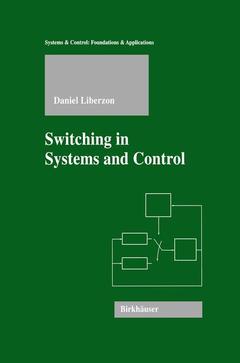Switching in Systems and Control, Softcover reprint of the original 1st ed. 2003 Systems & Control: Foundations & Applications Series
Langue : Anglais

l\lany systems encountered in practice involve a coupling between contin uous dynamics and discrete events. Systems in which these two kinds of dynamics coexist and interact are usually called hybrid. For example, the following phenomena give rise to hybrid behavior: a valve or a power switch opening and closing; a thermostat turning the heat on and off; biological cells growing and dividing; a server switching between buffers in a queueing network; aircraft entering, crossing, and leaving an air traffic control region; dynamics of a car changing abruptly due to wheels locking and unlocking on ice. Hybrid systems constitute a relatively new and very active area of current research. They present interesting theoretical challenges and are important in many real-world problems. Due to its inherently interdisci plinary nature, the field has attracted the attention of people with diverse backgrounds, primarily computer scientists, applied mathematicians, and engineers. Researchers with a background and interest in continuous-time systems and control theory are concerned primarily with properties of the contin uous dynamics, such as Lyapunov stability. A detailed investigation of the discrete behavior, on the other hand, is usually not a goal in itself. In fact, rather than dealing with specifics of the discrete dynamics, it is often use ful to describe and analyze a more general category of systems which is known to contain a particular model of interest.
I Introduction.- 1 Basic Concepts.- II Stability of Switched Systems.- 2 Stability under Arbitrary Switching.- 3 Stability under Constrained Switching.- III Switching Control.- 4 Systems Not Stabilizable by Continuous Feedback.- 5 Systems with Sensor or Actuator Constraints.- 6 Systems with Large Modeling Uncertainty.- IV Supplementary Material.- A Stability.- A.1 Stability definitions.- A.3 Lyapunov’s direct (second) method.- A.4 LaSalle’s invariance principle.- A.5 Lyapunov’s indirect (first) method.- A.6 Input-to-state stability.- B Lie Algebras.- B.1 Lie algebras and their representations.- B.3 Nilpotent and solvable Lie algebras.- B.4 Semisimple and compact Lie algebras.- Notes and References.- Notation.
The text adopts a progressive approach, presenting elementary concepts informally and more advanced topics with greater rigor Results are first derived for linear systems and then extended to nonlinear systems Full proofs for most results are provided An extensive bibliography and a section of technical and historical notes complete the work
Ouvrage de 233 p.
15.5x23.5 cm
Ouvrage de 233 p.
15.5x23.5 cm
© 2024 LAVOISIER S.A.S.



